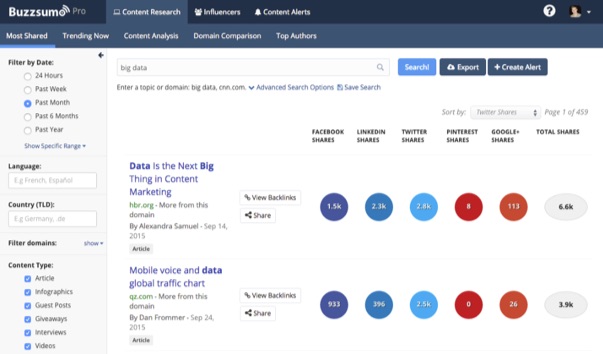KISSmetrics: Omni-Channel Marketing: A New Approach to Keyword Research
KISSmetrics: Omni-Channel Marketing: A New Approach to Keyword Research |
| Omni-Channel Marketing: A New Approach to Keyword Research Posted: 22 Sep 2016 10:45 AM PDT For many marketers, performing keyword research is a pretty standard procedure. What has primarily changed over time are the tools used to source key search queries and determine the quality and intent behind those keywords. While the approach to research remains largely the same, the landscape in which consumers search and move toward a purchase has changed. The path from search to purchase is no longer as linear as it once was and consumers generally don't follow clear paths anymore. Your approaches to keyword research and deployment of marketing content need to adjust for this omni-channel era. In this article, I'll define what this new path looks like, how you can adjust your strategy to be more visible to your ideal customers, and how targeted keyword research and optimization can lead to a dramatic improvement in engagement and retention. What is Omni-Channel? Up to this point, there have been a few different channel strategies for businesses, mainly offline businesses, but they're applicable to online retailers as well:
So what about omni-channel? This strategy involves using multiple visible channels which support one another in a single merged experience with the customer or prospect. The lines between channels blur as the brand and the customer engage across multiple mediums. For example: A customer pulls up your website to research an item while they're in your brick and mortar store. They search for other information online, which leads them to a blog post you wrote to address a specific pain point. A rep emails the customer some info on the product and they later order the product on your website or through your Facebook store integration. It's important to understand the omni-channel approach because it has transformed the way customers shop nowadays. 75% of shoppers who find helpful information alongside local retail info are more likely to visit those businesses. Likewise, over 70% of smartphone users research while shopping to help them make more informed decisions. Search Intent Across Multiple ChannelsSearch isn't the same creature it used to be. Today, search overlaps a variety of other channels as the results fill up with social media pages, local listings, videos, images, location-specific data, and more. While many marketers take a blanket approach to keyword research, many of those channels have their own search variations. Marketers mistakenly think the research they apply to search optimization also applies to social media and other channels. The truth is that the user's search experience varies greatly based on the platform and intent. Not only do you have behavioral differences across the channels (short queries on Twitter vs. multi-keyword queries on Facebook or YouTube), but there are also big differences in a standard search query vs. a conversational search in social media.  When researching keywords for the optimization of those individual channels, it's important to consider user intent for each channel, as well as the user's position in the buying cycle and whether or not they're searching for local information. Keyword Research for Omni-ChannelWhen you're conducting keyword research for organic search and content optimization, you're typically trying to determine the search volume and relevancy of keywords. For paid advertising, you'll also want to gauge how competitive a term is. Conducting keyword research for social and other channels as part of an omni-channel strategy is a bit more involved. When I perform research for omni-channel efforts, I have a lot of points to look at including:
Here's how you can perform this research on a few popular social channels: Facebook Keyword Research Consumers often turn to social channels like Facebook to see what other people are saying about a product, topic, trend, or brand. Keyword research on Facebook can provide a lot of insight when you're mapping out your optimization and marketing strategy:
From an omni-channel perspective, think about how your potential customers might be using Facebook to find information about your brand and your products or services. Build your keyword list and start researching with the Facebook search function. This will help you refine and locate more keywords, and from there, you can optimize your profile and plan the use of specific keywords within targeted public posts and content shares. Twitter Keyword Research Keyword research on Twitter is similar to Facebook. I recommend using the Advanced Search feature. This gives you more opportunities to narrow your targeting by date, location, and broad or exact match phrasing. The goal on Twitter is the same as on Facebook: you're looking for topic and keyword frequency, post and discussion intent, trending and relevant hashtags, and any opportunities to expand keywords. Considering the brevity of Twitter posts, you're less likely to see long tail search phrases being used. Instead, your audience is more likely to use shorter, topical words to find discussions, brand names, and product names. Like Facebook, this presents the opportunity to take the most relevant keywords you discover and work them into your posting strategy in order to get relevant content in front of the consumer. YouTube Keyword Research YouTube used to have its own keyword tool, but that was shuttered in 2015 as Google favored the use of Adwords Display Planner. This makes keyword research a little more complex for YouTube than other social channels, but it also provides a lot more data. If you use the AdWords Planner for any other type of keyword research, then you should be familiar with the process. Log in to Google AdWords and select the Display Planner under "Tools." From there, you can enter any search phrases you think your customers would be interested in and AdWords will display individual targeting ideas along with impressions and some basic demographics. Enter the keywords you develop into YouTube's search and examine the types of content that show up in the top results. You'll be able to piece together opportunities to create new content for those search phrases as well as optimize any existing videos you have to improve their visibility with the new search phrases. Just remember to make sure that you're always matching the search intent of the user. Omni-Channel Marketing Thrives on Content Omni-channel marketing doesn't target customers who are set on a purchase and are ready to place their order or head into the store. This kind of keyword research and optimization is meant to attract and educate the customers who are actively engaging you through multiple channels and researching information to help them make a purchase decision. For that reason, I always try to produce and position content that is most beneficial and relevant to the keywords I discovered during the research phase. To ensure that I'm consistently providing the best content, one tool I like to use is BuzzSumo. While the research process is predominantly manual for digging into topics and discussions on social, BuzzSumo automates things as you search for content. Plug in your keywords or relevant search queries, and BuzzSumo will display content to match – specifically the content that has received the most shares and engagement. You can use those results to craft your own content or curate those posts and share them publicly using targeted keywords across various channels. This way, no matter where your prospective customers are in the sales funnel – either online or in your store – they'll find your content and your high-value content shares, regardless of the channel in which they search. ConclusionFocused keyword research across multiple channels allows you to leverage public content to keep it in front of your audience, increasing the likelihood that they'll find you when they research purchasing options. More importantly, optimizing your content with keywords across multiple channels will capture the attention of the user. If a prospective customer finds your content through means other than search, then the relevant keywords will stand out and encourage them to start engaging you through multiple channels as they enter your funnel. Keyword research isn't just for organic search anymore. Use this information to improve your omni-channel visibility, attract new customers, and keep your current prospects engaged through to the conversion. What's your take on omni-channel marketing and the optimization of social channels? Share your thoughts with me in the comments below. About the Author: Aaron Agius is an experienced search, content and social marketer. He has worked with some of the world's largest and most recognized brands to build their online presence. See more from Aaron at Louder Online, their Blog, Facebook, Twitter, Google+ and LinkedIn. |
| You are subscribed to email updates from The Kissmetrics Marketing Blog. To stop receiving these emails, you may unsubscribe now. | Email delivery powered by Google |
| Google Inc., 1600 Amphitheatre Parkway, Mountain View, CA 94043, United States | |
